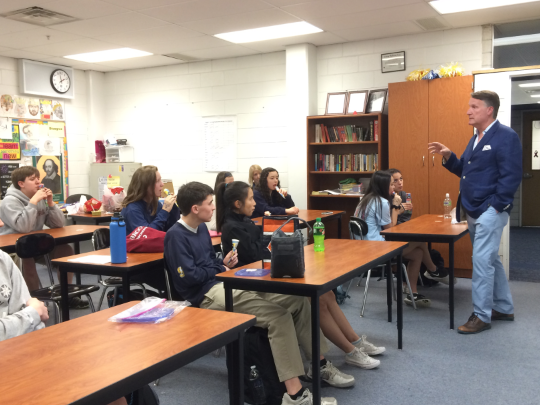South incorporates collaborative work in classes

SERVICE WITH SHELLARD: Speaking to a class of Sophomore Honors English students, Dr. Jim Shellard, assistant principal of student activities, emphasizes the importance of serving others. Shellardís remarks set forth the celebration of the service research projects.
May 27, 2016
This year, many teachers and programs throughout the school have been pushing toward a more collaborative work model for writing assignments.
Several teachers in the English Department have decided to give students the opportunity to work with other students on writing assignments this year. According to Dr. Tom Kucharski, English Department instructional supervisor, working with others in writing assignments gives students the opportunity to improve their writing skills by becoming more conscious of their process.
“It seems as if the collaborative process in writing helps make us more mindful about all of the different aspects that go into writing,” Kucharski said. “We’re less likely to write in a stream [but] more likely to write in an edited context.”
Danita Fitch, Foreign Language Department instructional supervisor says it is almost impossible to avoid collaboration in foreign language classes.
“I think in our department, every [assignment…], even the way that our classrooms have been designed in terms of the physical space, try to create more collaboration,” Fitch said.
This year, the Sophomore Honors English research projects were changed from an individual format to a partner format. English teacher Katie Hoover explained that the availability of technology and the cooperative nature of Google Drive is what allowed for the transition to partner work. According to Hoover, GBS has begun to develop a collaborative culture in and out of the classroom, and learning to work together will help students with their collaborative skills.
“One of the major skills that employers are looking for, with our students up and coming in the workforce, is their ability to collaborate,” Hoover said.
Hoover also said that past students have struggled with the research process on their own. She hoped the transition would help alleviate stress and give students an opportunity to share ideas while also dividing the workload.
For English teacher Debbie Cohen, the goal of the transition was to give students an opportunity to talk through their thinking process with another student. Each research topic is a big problem with many possible solutions which, Cohen said, could be cognitively overwhelming for some students.
“Having another person to bounce ideas off of and to do some comparisons in terms of ‘this is my understanding of the problem, this is my understanding of the solution, what’s yours?’, that conversation actually forces a lot of clarity for students individually and as a group,” Cohen said.
According to sophomore Hannah Goldberg, having a partner relieved a lot of stress for her during the process of writing the research paper.
“The workload would have been really large without a partner, but I think [working in pairs] was manageable,” Goldberg said. “Some of my friends didn’t have partners, but definitely having a partner made it a lot easier.”


